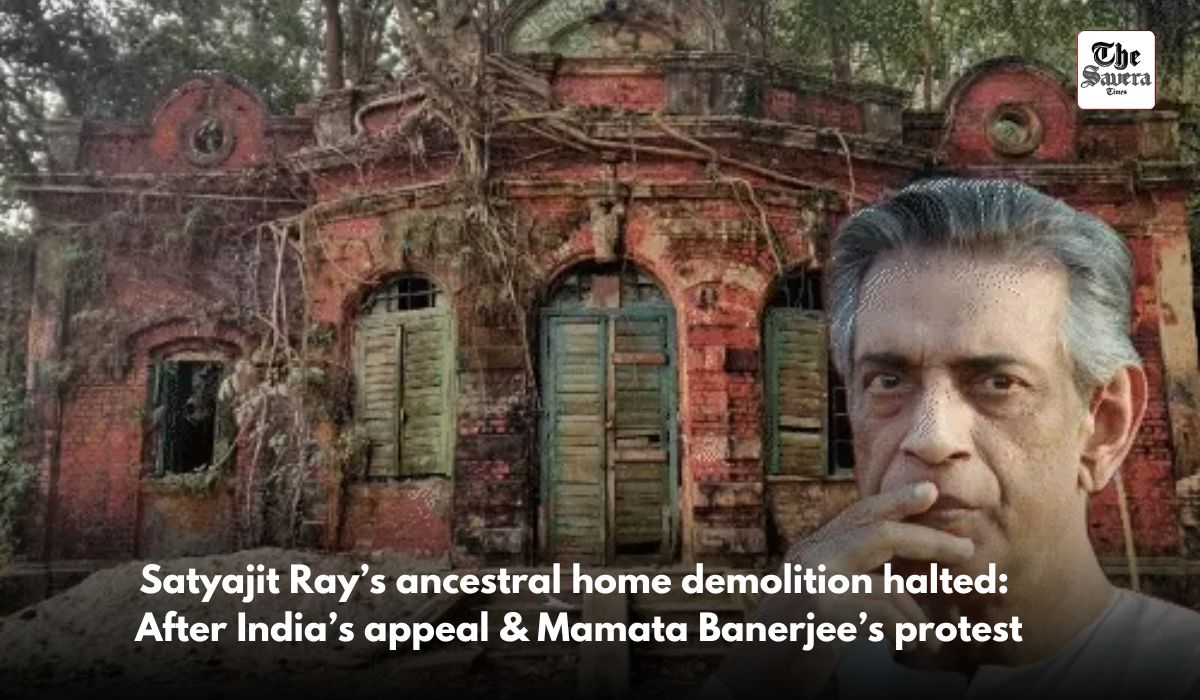
Dhaka, July 17: The demolition of the ancestral house of India’s famous film director Satyajit Ray in Bangladesh has been stopped. Satyajit Ray’s ancestral house is in Mymensingh city. The authorities have now formed a committee to decide how this house can be rebuilt.
India on Tuesday urged Bangladesh to stop the demolition of Satyajit Ray’s ancestral property. West Bengal Chief Minister Mamata Banerjee also opposed the demolition, saying the house is deeply linked to Bengal’s cultural history.
Satyajit Ray was a famous Indian film director, writer, musician and painter. He is considered one of the great filmmakers of world cinema. Satyajit Ray’s house in Bangladesh was built about a hundred years ago. After the partition in 1947, this property came under the Bangladesh government.
The administration admitted its mistake
This house is actually associated with Satyajit Ray’s grandfather, the famous writer Upendrakishore Ray Chowdhury. However, Faisal Mahmud, an official of the Bangladesh High Commission, said that Satyajit Ray himself never lived in this house.
He also said that Upendrakishore may not have lived in this house, as he lived in a place called Kotiyadi in the nearby Kishoreganj district. His original house there still exists and is protected as a heritage site.
He also said that there are 531 such protected sites in Bangladesh’s heritage list, but this house in Mymensingh was not on that list. It was the administration’s mistake that this house was not added as a heritage site, so there was no legal obligation to protect it. Yet now that there is controversy over it, the government is reconsidering it.
The Indian government had expressed concern
Faisal Mahmud said that Satyajit Ray does not belong only to India or Bangladesh, he is the heritage of the whole world. He is also a pride for all Bangladeshis.
Earlier, the Government of India expressed serious concern over the issue and said that it is very unfortunate that Satyajit Ray’s ancestral house in Mymensingh is being demolished. This is the same house which was associated with his grandfather Upendrakishore Ray Choudhary and has been a symbol of Bengal’s cultural renaissance.
India said that the building is the property of the Bangladesh government and is in a bad condition, but given its historical and cultural importance, it would be better to convert it into a museum or cultural site instead of demolishing it. The Indian government also offered to assist in its reconstruction and preservation.
West Bengal Chief Minister Mamata Banerjee also called it an “extremely sad” incident and said that the Ray family is a major symbol of Bengali culture. She appealed to the Bangladesh government to preserve this historical building. She wrote on social media that Upendra Kishore has been the pillar of Bengal’s renaissance and the preservation of this house is necessary.
Satyajit Ray was given the Lifetime Achievement Award at his home
Satyajit Ray was born on 2 May 1921 in Kolkata, West Bengal. He belonged to a distinguished Bengali family and his grandfather Upendrakishore Ray Chowdhury was a famous writer and painter. Satyajit Ray’s first film was Pather Panchali, which received great international acclaim.
This was the first part of the ‘Apu Trilogy’, a series of three films released in Bengali language. Pather Panchali released in 1955, Aparajito released in 1956 and Apur Sansar released in 1959 are called the ‘Apu Trilogy’.
Satyajit Ray directed a total of 37 films. These include feature films, documentaries, and short films. His contribution to Indian cinema can be gauged from the fact that the Oscar Committee came to his house in Kolkata to give him the Oscar for Lifetime Achievement. Satyajit is the first Indian filmmaker to receive the Lifetime Achievement Oscar.
Satyajit composed music for many of his films himself. He also wrote dialogues himself. The Government of India awarded him the country’s highest civilian honours, Padma Bhushan in 1965, Padma Vibhushan in 1976, and Bharat Ratna posthumously in 1992. He died on 23 April 1992 in Kolkata.
